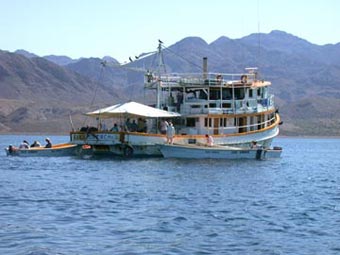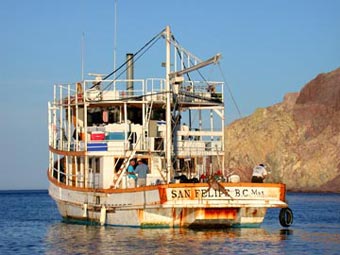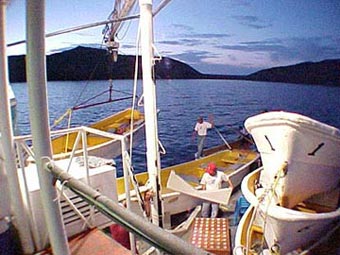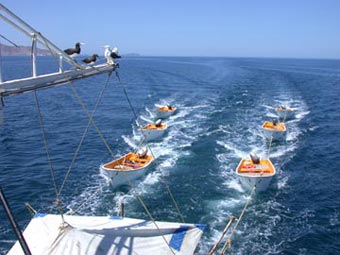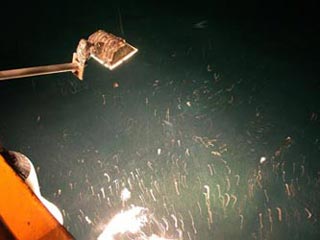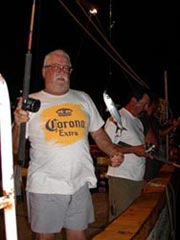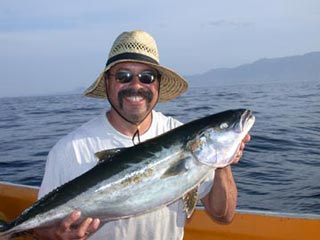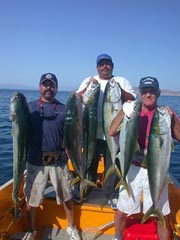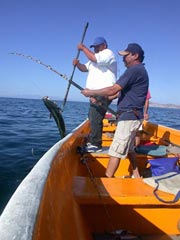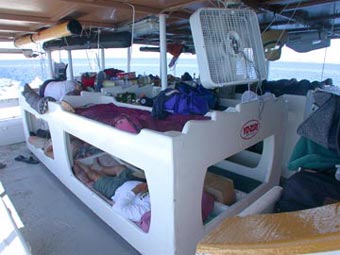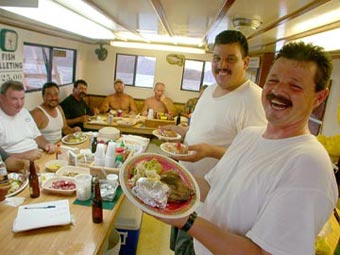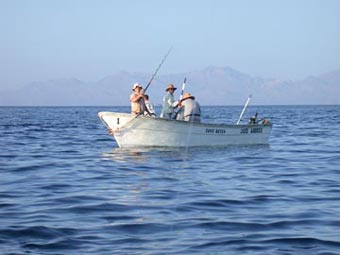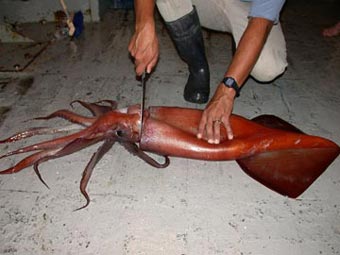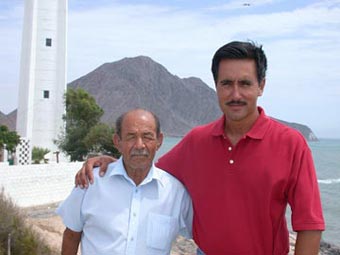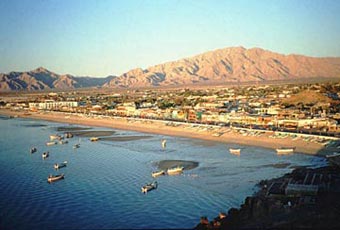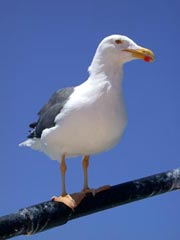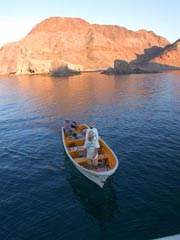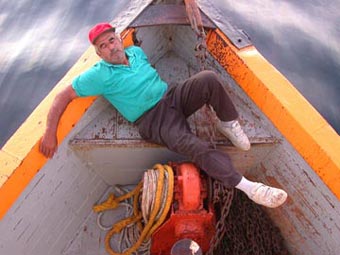
San Felipe's Traditional Panga Motherships:
Fishing Baja's Midriff Islands
![]()
|
The San Felipe panga mothership, Jose Andres, a commercial shrimp trawler converted for sportfishing, carries 18 anglers, 12 guides and crew, and six traditional Mexican pangas, 22-foot fiberglass skiffs powered by outboard motors, to fish several hundred miles down the Sea of Cortez archipelago from San Felipe. (See: Tony Reyes, Spiritual Patriarch of San Felipe.) |
A HALF-CENTURY OLD SPORTFISHING TRADITION AT SAN FELIPE, MEXICO
By GENE KIRA
If you’re ever in need of some real strong Baja fishing medicine to soothe your soul (or just fill your ice chest), you will have to look far and wide for anything stronger than a San Felipe panga mothership trip to the Midriff islands. (Midriff Islands Fishing Map.)
During these six-day cruises to the beautiful central Sea of Cortez archipelago out of the port of San Felipe located at the north end of Mexico's Sea of Cortez, you do nothing but fish, relax, fish, relax, and fish some more...until you are truly saturated.
|
|
The action is heavy and good, and a huge bonus is the privilege of visiting the remote area itself, where few tourists ever go, and of witnessing the teeming, vital blast of sea life that is the Midriff in summer.
Ray Cannon--Western Outdoor News' first Baja editor--invented the term “Midriff” about 1955 to describe this hourglass-shaped central portion of the Sea of Cortez, where it narrows down to a width of only about 75 nautical miles.
But contrary to popular belief, Cannon’s usage of the term “Midriff” did not refer just to the narrowing of the sea at this point, but also to the amazing, life-filled “riffs” or tidal currents he observed during his early explorations of the area.
As Ray described it: “We saw...great hungry whirlpools which trapped and swallowed all transient sea life. Hosts of jellyfish and a massive strew of sargassum seaweed circled toward the center and then zipped down the maw and disappeared...I feel that a sizable skiff would have gone down like a match.”
It is arguable whether or not the Midriff’s powerful tidal currents alone could actually sink a skiff, but one thing is certain: The incredible density and variety of marine life Ray Cannon found here literally dumbfounded him and he struggled for the rest of his career to describe it adequately.
|
The San Felipe panga motherships carry their pangas on their rear decks until they are needed on the fishing grounds. The skiffs are then towed from island to island, usually for two sessions of heavy fishing per day. |
In this remote, sometimes truly wild sea were scores of game fish species, including cow-sized groupers and basses with mouths big enough to engulf a beer keg, millions of marlin-sized totoaba spawning against the beaches in schools so thick you could spear them with your eyes closed, and yellowtail, yellowtail everywhere, so abundant they were thought of as “nuisance fish” by some anglers.
Here, in an area only about 150 miles long and 80 miles wide, were packed more than two-dozen islands and larger rocks, and between them were fantastically steep channels, some of them more than a mile deep.
And driven by the powerful, nutrient-rich upwellings coming up from the bottoms of those Midriff channels, were almost unbelievably dense plankton blooms--of red, brown, green, milky blue, tan, yellow, and every other imaginable hue of the rainbow--all of it going to feed massive schools of sardines, mackerel, squid, and other forage species of every description.
Today, as in Ray Cannon’s era, the Midriff is the remotest part of the Sea of Cortez, with only one paved access road on the Baja side, at Bahia de los Angeles. And as in Ray Cannon’s era, there is still only one practical, easy way to visit the islands and fish their fascinating waters--by taking a San Felipe panga mothership from the north end of the Sea of Cortez.
|
"Making bait," is a frequent nightly routine for San Felipe's panga motherships, using lights to attract the preferred live mackerel, which are caught with "Lucky Joe" ganions of four to six small feathers, each hiding a tiny hook. The quickly unhooked mackerel are kept alive in a bait tank (lower left) until needed. |
SAN FELIPE’S MOTHERSHIPS
San Felipe’s panga mothership industry got its start about 1953 when commercial shrimp boats were first hired to take sport anglers south to the nearby Enchanted Islands off Gonzaga Bay.
About 1955, these early San Felipe boats extended their range to fish the northern parts of the Midriff itself, including 50-mile long Isla Angel de la Guarda.
The first San Felipe mothership trips were quite rough by modern standards, and they were patronized by anglers willing to endure almost any hardship in order to get at the fantastic fishing. The only “head” on some of these boats was a good firm grip on the side rail, and one early promotional brochure published in 1954 proudly proclaimed that on-board meal service included: “paper plates and cups, wooden forks and spoons and plastic knives; new ones each meal.”
Although the quality of accommodations on these early trips left something to be desired, there was never a question about the quality of the fishing. In May of 1956, Ray Cannon described the action on an exploratory trip along the Baja coast from Ensenada Grande, south to Bahia de los Angeles:
“A small hand-lining commercial had caught three tons of black sea bass...We landed nine and farmed a like number.
“A short stop at Ensenada Grande produced three black sea bass--one was 5 feet 6 inches long. We farmed about a dozen.
“In addition to the black sea bass grounds we found areas loaded with totuava, corvinas, yellowtail, large red snappers and a gulf full of goldspotted bass which proved a killer as live bait.”
|
Mike Alaniz (left) with guide Jorge, and a catch of yellowtail made within a few minutes of furious action at the south end of the Midriff's Isla Angel de la Guarda. Yellowtail and cabrilla, or leopard grouper, are the main catch of the San Felipe panga motherships. |
News of such fishing out of San Felipe spread rapidly, and an industry was born at San Felipe that has endured, pretty much unchanged, for the last half-century. The early rented commercial shrimp boats were phased out, and true sportfishing motherships were brought into operation, with live bait tanks, modern electronics, full-sized pangas, air conditioned cabins, bathrooms, showers--and excellent meal service (with metal knives and forks!).
Today, three mothership companies operate at San Felipe, with four fully customized boats, about 100 departures, and more than 2,000 anglers per season taken on six-day trips to the still very productive Midriff Islands.
San Felipe boats now routinely range throughout the Midriff area, as far south as Isla San Lorenzo, and sometimes even as far as Isla San Pedro Martir, the most remote island of the Sea of Cortez. The fishing is admittedly not what it was in Ray Cannon’s era, especially for slow-growing groupers and giant sea basses, which have become rare. But even today, the islands produce a reliably heavy catch of yellowtail, leopard grouper, snappers, white sea bass, and a galaxy of lesser bottom fish such as triggerfish, sheephead, ocean whitefish, and many others.
|
Today's San Felipe panga motherships, here the Jose Andres, all have air conditioned cabins, although many passengers elect for the traditional on deck bunks, supplemented by fans in hot weather. Three hearty meals are served per day in the ship's galley. |
MIDRIFF BOTTOM FISHING
The Midriff may have gotten its name partly from its spectacular surface currents, but from the beginning, the essential nature of its sportfishing action has been on the bottom.
Centered about one-third the way down the Sea of Cortez, Midriff waters are characterized by tremendous tidal upwellings, which do two things detrimental to surface fishing:
First, they reduce surface water temperatures, which even during the summer struggle to get into the ranges favored by big game glamor species. In midsummer, the Midriff becomes a pond of cool water typically reaching average temperatures only into the high-70s, while the Sea of Cortez both north and south of it can be in the high-80s. Dorado, tuna, marlin, and sailfish are all occasionally caught in the Midriff, but not in numbers and not consistently.
Secondly, these deep, cool Midriff upwellings are extremely rich in nutrients, which combine with the nuclear-burst intensity of the area’s desert sunlight to produce constant plankton blooms. Midriff waters are typically green, brown, red, almost any color other than the deep, clear blue that accompanies good surface fishing.
There is actually a third good reason to fish the bottom in the Midriff area: it is mind-bogglingly productive. The Midriff’s heavy plankton density may not be very conducive to good underwater photography, but it does support a corresponding density of resident biomass that is probably unmatched anywhere else in the Sea of Cortez. Even after half a century of sport and commercial fishing, with all the sweat and technology that man can muster, the Midriff still kicks out consistently heavy catches of bottom and midwater fish species, lead by its most sought-after quarry, the feisty, good-eating yellowtail.
Due to its strongly contrasting, swirling warm and cool currents, driven by the countervailing forces of warm sun and deep upwelling, the Midriff’s sea life is a true smorgasbord of unusual species. Strange things are caught that defy identification, including fish, many kinds of eels, and benthic creatures rarely observed elsewhere.
Most of the Midriff’s bottom fish species, of course, are also encountered in midwater, and sometimes there is also good surface action, but to fish these waters consistently, you should best be prepared to battle the main body of fish, from about 50 to over 300 feet deep.
|
The San Felipe panga motherships never know what their anglers will catch in the Midriff's incredibly productive and varied waters. In addition to the bread-and-butter yellowtail and cabrilla, Humboldt squid, red snapper, white seabass, huge groupers, whitefish, sheephead, dorado, and an enormous variety of "miscellaneous" fish are brought into the pangas. |
MOTHERSHIP TRIPS
Life on a San Felipe panga mothership is a lazy routine. You have no real responsibilities, other than to keep your beer tab honest, show up for the three all-you-can-eat meals per day included with your trip, help make bait at night, and get into your panga when your guide calls you.
Even your tackle box and rods are loaded and unloaded by your panguero, who will also bait your hook, gaff your catch, tag it, fillet it, and pack it in ice. The service is so efficient on these trips, you could easily go an entire week--and load your ice chest with fillets--without ever touching anything but your rods and reels. Anything that sounds even remotely like “work” is done by somebody else.
San Felipe’s panga motherships are divided into two classes, the smaller wood-hulled boats, and the larger steel-hulled ones. The larger boats are faster and have all air-conditioned cabins, but there are more bodies aboard and some intimacy with the sea is sacrificed by their increased size and freeboard. The smaller wooden boats are more “rustic,” with air-conditioned cabins for only some anglers, while others sleep in covered, outside bunks on the upper deck. Their smaller passenger load makes the wood boats seem a bit more peaceful, and their closeness to the water gives a better feel for the sea. There are advantages to both platforms.
The boats leave San Felipe on Saturday or Sunday morning, and they cruise slowly south about 250 miles, through the night, for your first day of fishing, after the pangas have been lifted off the rear deck by crane and lowered into the water.
Each day, you fish in the morning--usually with three anglers per panga--return to the boat for lunch and a short nap, and then fish again until almost dark. The boat moves while you sleep, eat, and rest, so you are constantly seeing new islands and reefs, and most nights you will stop somewhere to make mackerel.
Although fishing is the main purpose of your trip, you can also enjoy beach combing, snorkeling, whale watching, and just plain sightseeing as the boat cruises throughout the Midriff archipelago and visits several major islands on each trip, including Angel de la Guarda, Partida, Raza, Salsipuedes, Animas, San Lorenzo, San Esteban, and sometimes San Pedro Martir or even Tiburón.
(The chain of small islands stretching south from large Isla Angel de la Guarda is the Midriff’s famous “Yellowtail Alley.” While it is true that these islands are very good for yellowtail, the name could actually apply to the entire Midriff area; depending on currents and season, yellowtail are frequently caught off every island and in every channel.)
|
The living legend, Don Tony Reyes Baca (left) serves as the spiritual patriarch of the modern town of San Felipe. Today, his son, Tony Reyes Montez, captains their flagship, the steel-hulled panga mothership, Tony Reyes, which they operate alongside their traditional wood-hulled ship, the Jose Andres. |
One of the most enjoyable aspects of a Midriff trip is the passing spectacle of sea life surrounding the boat. Whales, porpoise, birds, seals, jellyfish, spectacular plankton displays, and huge surface boils abound. Here, a large brown mass rising above the surface might be a feeding school of giant Humboldt squid, or at night, you may see ghostly, glowing porpoise beneath your boat, lit up by the luminescent phytoplankton they are swimming through. Just making mackerel at night is an experience, as innumerable forms of sea life are attracted to the lights.
But the fishing itself is the main event, and fish you will. The action is typically quite intense, and by the third day, some anglers will begin skipping either the morning or afternoon session. If the bite is heavy, there may be times when the pangas fish half-empty. If it’s really heavy, some sessions may actually be skipped. By the end of the six-day trip, most anglers have truly “had it” and are quite ready to make a well-satisfied return to San Felipe.
MIDRIFF SEASONS
Although the Midriff’s resident fish species are--well, resident--winter is not a good time to fish for them because it’s too windy for comfort and safety, and the fish are less active in very cool water temperatures that may get down to about 50 degrees. San Felipe’s motherships typically make their trips from about March through November.
In March, as winter winds abate and water temperatures begin to rise, the bite picks up over the reefs on the major resident species: yellowtail, leopard grouper or “cabrilla,” white seabass, snappers, broomtail grouper, whitefish, Humboldt squid, black seabass, gulf grouper, spotted cabrilla or “pinto bass,” and a host of incidental species too numerous to count. From March through May, these species come close to the surface to spawn, then gradually descend again.
Fishing action intensifies through July, when residents are sometimes joined by migratory surface species approaching the northern limits of their ranges. These may include occasional dorado, roosterfish, amberjack, sometimes tuna, and even a stray sailfish or marlin now and then.
August is uncomfortably hot for some anglers, with higher humidity, afternoon air temperatures pushing 100 degrees and water temperatures peaking at about 80 or 82 degrees. There is sometimes a slight lull in both surface and bottom fishing, which pick up again in September and October.
September is a good fishing month that starts out hot, but with somewhat cooler weather during its second half. However, it is also the month of highest “big wind” probability, when chubascos, tropical storms, and even the occasional hurricane may invade the Sea of Cortez.
October is a peak month, with good bottom fishing, many migrators still around, air temperatures about 10 degrees cooler than their summer peaks, less humidity, and less risk of really serious blows.
By late November, water temperatures are cooling down through the high-60s, as the migrators leave town, resident fishing action tapers off, and winter winds once again take control of the Sea of Cortez by about Thanksgiving.
|
A beautiful day on the Sea of Cortez. San Felipe's panga motherships visit remote parts of the Sea of Cortez seen by few tourists. |
TACKLE & TECHNIQUE
All tackle taken to the Midriff islands should be of top quality and in good condition. On yellowtail, especially, it is best not to fool around with light tackle. Just do business, and congratulate yourself for not getting rocked. On huge bass and grouper species, you will often lose anyway, no matter what tackle you use. This is not “finesse” fishing with your little fingers held out.
In order of probable frequency, you will be soaking live bait, jigging or yo-yoing iron, casting iron, and trolling on or near the surface. Lures are tied on direct, and bait is tied on heavy dropper loops. Nothing fancy. The fish are usually not line shy.
In addition to the standard rod belt, pliers, Leatherman, drag washers, and extra line, you need three basic outfits:
1. A 20-pound conventional or spinning outfit for making bait. Use Sabiki rigs in several sizes, and six-ounce torpedo sinkers. When making bait from the boat, use more weight than you really need to get down. The rail is crowded. If you hook three or four mackerel and you don’t have a lot of weight on, you’ll tangle half the boat before you get them up.
2. A 40-50 pound, 7-8 foot jig stick for casting and yo-yoing lures, medium bait fishing, and trolling. Take bait hooks of #1 to about 9/0, and torpedo sinkers of 8, 12, and 16 ounces. Take plenty of iron jigs, such as Salas 6X and 6X Jr., Stingers, and Bridgeport Diamond Jigs, in chrome, blue-white, all-white, and scrambled egg. Include at least a couple of jigs in the one-pound range. Take medium trolling plugs, such as Rapala CD14 and CD18 Magnums in green mackerel, fire-tiger, and orange-gold. Take trolling “feathers” for dorado, such as 6-inch “albacore” feathers, and “skirted-squids” as described in The Baja Catch. Basic feather colors should be: purple-black, all-white, and green-pink. The reel for this outfit should be high ratio, about 5:1, for jigging/yo-yoing rapidly, and it should be able to hold, say, 300 yards of 50-pound line.
3. An 80-100 pound outfit for heavy bait and jig fishing, with the stiffest 6-foot rod you can find. Same hooks and sinkers. For trolling, add heavy, deep diving plugs, such as the MirrOlure 111MR in purple-black, hot-pink, orange-gold, green-mackerel, and blue-silver. The reel for this outfit should be 6/0 or larger, and low-ratio or two-speed. If it’s a lever drag, it should be a fairly big one, so you can get enough drag and still have free spool. You don’t actually need a lot of line capacity; yellowtail runs are very powerful but short, so about 300 yards is plenty. However, you’ll want a bigger reel than that, because you need the drag pressure, cranking power, and general strength.
4. For black seabass and big grouper, at least 100-pound line, sinkers up to 20 ounces, hooks up to 12/0, and heavy mono or wire leader.
5. For Humboldt squid, take several squid jigs, ranging from small five inchers, up to the foot-long models sold in Baja.
|
Heading for home, after six day's of continuous fishing and running, ship's engineer Vicente naps on the bow of the Jose Andres, on the long cruise back to its home port of San Felipe. |
THIS & THAT
Full details are available from the San Felipe mothership companies, but here are a few tips than will make your trip go smoother:
--Required documentation includes proof of citizenship, possible tourist card, a Mexican fishing license, and Mexican vehicle insurance for your drive to San Felipe and back to the border. Tourist cards may not be needed, depending on current enforcement procedures. Fishing licenses can probably be provided by the boat, but check to be sure with your tour operator.
|
|
--It is best to arrive in San Felipe the evening before boat departure and stay in a motel.
--Dress for possibly hot weather, but always bring at least a light jacket, or even a medium jacket, especially at the beginning or end of the season. Wear a good hat and sun-protective clothing for the panga, combined with beach wear for relaxing.
--It is good to bring ear plugs, a small flashlight, and a large electric fan, if you plan to sleep on an outside bunk in hot weather. A sleeping bag for cool seasons, or a very large bath towel for hot weather is nice for covering your bunk, and of course, bring an ice chest for your fish.
--Meals are included and your fish are tagged and packed in ice during the trip. Extra cost items include beverages, fillet service at the end of the trip, and tips for your guide and crew.
CONTACT INFORMATION
All three San Felipe mothership companies provide full information, parking during your trip, shuttle service to and from the marina, etc. Their phone numbers are:
--Baja Sportfishing Inc., with the 105-foot Erik, 800-770-2341.
--Sea of Cortez Sportfishing, with the 87-foot Celia Angelina, 626-333-9012.
--Tony Reyes Fishing Tours, with the 87-foot Jose Andres and the 107-foot Tony Reyes, 714-538-8010.
(Related San Felipe articles and reports may be found at Mexfish.com's main San Felipe information page. See weekly fishing news, photos, and reports from the major sportfishing vacation areas of Mexico including the San Felipe area in "Mexico Fishing News.")
MEXICO FISHING INFO SAN FELIPE FISHING INFO "WEEKLY MEXICO FISHING NEWS" FISH PHOTO GALLERY
